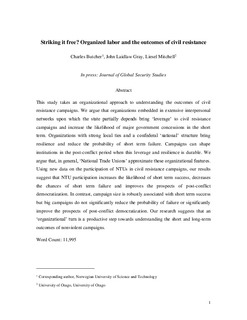| dc.contributor.author | Butcher, Charles | |
| dc.contributor.author | Gray, John Laidlaw | |
| dc.contributor.author | Mitchell, Liesel | |
| dc.date.accessioned | 2019-01-22T10:03:47Z | |
| dc.date.available | 2019-01-22T10:03:47Z | |
| dc.date.created | 2017-11-16T08:17:35Z | |
| dc.date.issued | 2017 | |
| dc.identifier.issn | 2057-3170 | |
| dc.identifier.uri | http://hdl.handle.net/11250/2581710 | |
| dc.description.abstract | This study draws from organizational theory to explain the outcomes of civil resistance campaigns. Organizational theory suggests that organizations embedded in extensive interpersonal networks upon which the state partially depends bring “leverage” to civil resistance campaigns and increase the likelihood of major government concessions in the short term. Also, organizations with strong local ties and a confederal “national” structure should bring resilience and reduce the probability of short term failure. We argue that, in general, National Trade Unions (NTUs) approximate these organizational features. Using new data on the participation of NTUs in civil resistance campaigns, our results suggest that NTU participation increases the likelihood of short-term success and decreases the chances of short-term failure. NTU participation also improves the prospects of postconflict democratization. In contrast, campaign size is robustly associated with short-term success but not with the probability of failure or postconflict democratization. Our research suggests that an “organizational” turn is a productive step toward understanding the short- and long-term outcomes of nonviolent campaigns. | nb_NO |
| dc.language.iso | eng | nb_NO |
| dc.publisher | Oxford University Press | nb_NO |
| dc.title | Striking it Free? Organized labor and the outcomes of civil resistance | nb_NO |
| dc.type | Journal article | nb_NO |
| dc.type | Peer reviewed | nb_NO |
| dc.description.version | acceptedVersion | nb_NO |
| dc.source.pagenumber | 302–321 | nb_NO |
| dc.source.volume | 3 | nb_NO |
| dc.source.journal | Journal of Global Security Studies | nb_NO |
| dc.source.issue | 3 | nb_NO |
| dc.identifier.doi | 10.1093/jogss/ogy010 | |
| dc.identifier.cristin | 1514643 | |
| dc.description.localcode | Locked until 4.7.2020 due to copyright restrictions. This is a pre-copyedited, author-produced version of an article accepted for publication in [Journal of Global Security Studies] following peer review. The version of record is available online at: https://doi.org/10.1093/jogss/ogy010 | nb_NO |
| cristin.unitcode | 194,67,25,0 | |
| cristin.unitname | Institutt for sosiologi og statsvitenskap | |
| cristin.ispublished | false | |
| cristin.fulltext | postprint | |
| cristin.qualitycode | 1 | |
